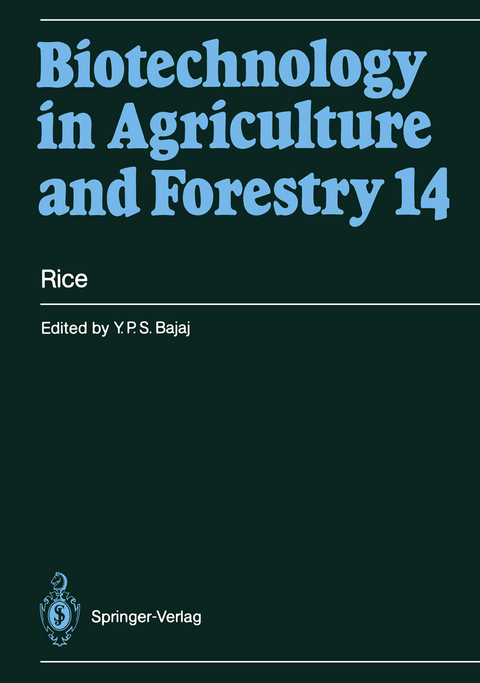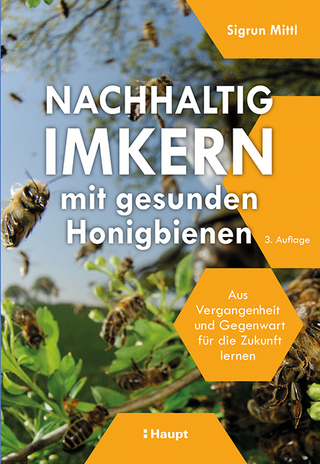
Rice
Springer Berlin (Verlag)
978-3-642-83988-7 (ISBN)
Section I Establishment of Tissue Cultures, Somatic Embryogenesis, Plant Regeneration, and Ultrastructural Studies.- I.1 Biotechnology in Rice Improvement.- I.2 Rice (Oryza sativa L.): Establishment of Callus Cultures and the Regeneration of Plants.- I.3 Regeneration of Rice Plants from Suspension Cultures.- I.4 Enhancement of Regeneration in Rice Tissue Cultures by Water and Salt Stress.- I.5 Early Events in Zygotic and Somatic Embryogenesis in Rice.- I.6 Endosperm Culture and the Regeneration of Triploid Rice Plants.- I.7 Ultrastructural Aspects of Rice Scutellum as Related to Seminal Root Cultures.- Section II Hybridization, Embryo Culture, Hybrid Rice.- II.1 Embryo Culture for Wide Hybridization in Rice.- II.2 Improvement of Tongil-Type Rice Cultivars from Indica/Japonica Hybridization in Korea.- II.3 Genetics of Hybrid Sterility in Wide Hybridization in Rice (Oryza sativa L.).- II.4 Hybrid Rice in China - Techniques and Production.- Section III Anther Culture, Haploid Production, and Release of Cultivars.- III.1 Anther Culture for Rice Improvement in China.- III.2 In Vitro Production of Haploids in Rice Through Ovary Culture.- III.3 Factors Affecting Androgenesis in Rice (Oryza sativa L.).- III.4 Breeding New Rice Strains Through Anther Culture.- III.5 Huayu 15, a High-Yielding Rice Variety Bred by Anther Culture.- Section IV Protoplast Isolation, Fusion, Culture, and Field Trials of Regenerated Plants.- IV.1 Isolation, Culture and Fusion of Rice Protoplasts.- IV.2 Field Performance of Protoplast-Derived Rice Plants and the Release of a New Variety.- Section V In Vitro Mutation and Somaclonal Variation.- V.1 In Vitro Mutation in Rice.- V.2 Rice Mutants Resistant to Amino Acids and Amino Acid Analogs.- V.3 Hydroxy-L-Proline-Resistant Mutants in Rice.- V.4Utilization of Somaclonal Variation in Rice Breeding.- V.5 Male Sterile Mutants from Rice Somaclones.- V.6 Somaclonal Variation for Salt Tolerance in Rice.- V.7 Somaclonal Selection for Tolerance to Streptomycin and Herbicides Through Rice Cell Culture.- V.8 Rice Somaclones Resistant to Xanthomonas Oryzae.- Section VI Transformation, Molecular Biology, and Nutritional Improvement.- VI.1 Transformation in Rice.- VI.2 Molecular Analysis of Rice Genes and Methods for Gene Transfer.- VI.3 Plasticity of the Rice Genome: DNA Amplification in Cultured Cells.- VI.4 Molecular Structure of Chloroplast DNA from Rice.- VI.5 Molecular Markers in Rice Systematics and the Evaluation of Genetic Resources.- VI.6 Rice Storage Proteins: Genetic Analysis of Accumulation Process.- VI.7 Biotechnology in Nutritional Improvement of Rice.- Section VII Conservation of Genetic Resources and Cryopreservation.- VII.1 Conservation and Potentials of Rice Genetic Resources.- VII.2 Cryopreservation of Germplasm of Rice.- Section VIII Rice Tissue Culture Studies in the USSR, France, and Hungary.- VIII.1 Rice Improvement Through Tissue Culture in the USSR.- VIII.2 Rice Somatic Tissue and Anther Cultures: Current Status in France.- VIII.3 In Vitro Studies on Rice in Hungary.
| Erscheint lt. Verlag | 20.11.2013 |
|---|---|
| Reihe/Serie | Biotechnology in Agriculture and Forestry |
| Zusatzinfo | XXIII, 645 p. 309 illus., 188 illus. in color. |
| Verlagsort | Berlin |
| Sprache | englisch |
| Maße | 170 x 242 mm |
| Gewicht | 1065 g |
| Themenwelt | Weitere Fachgebiete ► Land- / Forstwirtschaft / Fischerei |
| Schlagworte | Biotechnologie • Biotechnology • Development • Pflanzenzüchtung • Pflanzliche Gewebekultur • Plant Tissue culture • Reis • Rice |
| ISBN-10 | 3-642-83988-6 / 3642839886 |
| ISBN-13 | 978-3-642-83988-7 / 9783642839887 |
| Zustand | Neuware |
| Haben Sie eine Frage zum Produkt? |
aus dem Bereich


